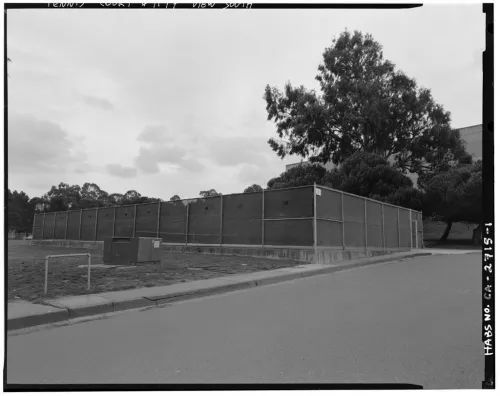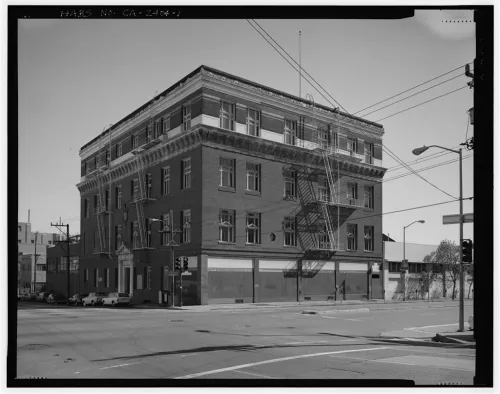Share what you know,
and discover more.
Share what you know,
and discover more.

-

- Marley Zielike
California State Building, 350 McAllister St San Francisco, San Francisco County, CA
The California State Building is a contributing element of the San Francisco Civic Center Historic District, which is listed on the National Register of Historic Places and is a designated National Historic Landmark. For a discussion of the Civic Center, refer to the Historical Context section. According to the National Register nomination, "[t]he San Francisco Civic Center is regarded by many scholars as the finest and most complete manifestation of the City Beautiful Movement in the United States. The City Beautiful Movement intended to create beauty and order in cities which had grown too fast as a result of industrialization and accelerated immigration, and as such was an aspect of the general municipal reform movement that sprang up in the 1890s and continued after the turn of the century." "The development of the State Building served important practical and symbolic functions in the development of the whole Civic Center. The original announcement to build the State Building, timed just before the bond election of 1912, was a factor in the public approval of the project. The actual construction of the building during the building depression of the 1920s served to keep the idea of a complete Civic Center alive during a difficult and slow time when prospects for a Federal Building and an Opera House seemed far away at best. The fact of the state`s participation in an essentially municipal project and the complete cooperation of state officials with local planners in the competition and construction demonstrated the acceptance of City Beautiful and the Civic Center ideals by a larger, and important, public body. The building balances the Exposition Auditorium across the Plaza in occupying the full street frontage. Despite criticism at the time of the competition that that State Building reinforced the already ill-proportioned Plaza, the masterful handling of the War Memorial complex has given new credence to the design of the State Building and its relationship to other Civic Center buildings. Equally important, it clearly indicates the inter-relationships of all the buildings, functioning as a unit rather than as individual structures in isolation. The architectural firm of Bliss and Faville was one of the most established and well respected firms in San Francisco when the State Building competition was held in 1915. Walter D. Bliss and William B. Faville were highly professional architects who kept abreast of contemporary developments on the East Coast. In the consistently high quality of their designs they were important contributors to the raising of design standards in the Bay Area, particularly in commercial architecture. Both men were schooled in the Beaux Arts tradition, Faville attending MIT, and both men apprenticing under McKim, Mead and White in New York. They came to San Francisco in 1898 as partners and worked together until 1925 when each continued to practice alone. Faville was the more prominent figure, serving on the architectural committee of the 1915 Exposition which determined the site of the Civic Center, and from 1922-1924, he served as the national president of the American Institute of Architects. In addition to the State Building, their important commissions included the St. Francis Hotel on Union Square, the Bank of California building on California Street and the Geary Theater. They also designed the Palace of Education and many lesser buildings at the Panama-Pacific International Expositions. It is a tribute to their ability as designers and planners that virtually all of their major commissions are still in active use."
California State Building, 350 McAllister St San Francisco, San Francisco County, CA
The California State Building is a contributing element of the San Francisco Civic Center Historic District, which is listed on the National Register of Historic Places and is a designated National Historic Landmark. For a discussion of the Civic Center, refer to the Historical Context section. According to the National Register nomination, "[t]he San Francisco Civic Center is regarded by many scholars as the finest and most complete manifestation of the City Beautiful Movement in the United States. The City Beautiful Movement intended to create beauty and order in cities which had grown too fast as a result of industrialization and accelerated immigration, and as such was an aspect of the general municipal reform movement that sprang up in the 1890s and continued after the turn of the century." "The development of the State Building served important practical and symbolic functions in the development of the whole Civic Center. The original announcement to build the State Building, timed just before the bond election of 1912, was a factor in the public approval of the project. The actual construction of the building during the building depression of the 1920s served to keep the idea of a complete Civic Center alive during a difficult and slow time when prospects for a Federal Building and an Opera House seemed far away at best. The fact of the state`s participation in an essentially municipal project and the complete cooperation of state officials with local planners in the competition and construction demonstrated the acceptance of City Beautiful and the Civic Center ideals by a larger, and important, public body. The building balances the Exposition Auditorium across the Plaza in occupying the full street frontage. Despite criticism at the time of the competition that that State Building reinforced the already ill-proportioned Plaza, the masterful handling of the War Memorial complex has given new credence to the design of the State Building and its relationship to other Civic Center buildings. Equally important, it clearly indicates the inter-relationships of all the buildings, functioning as a unit rather than as individual structures in isolation. The architectural firm of Bliss and Faville was one of the most established and well respected firms in San Francisco when the State Building competition was held in 1915. Walter D. Bliss and William B. Faville were highly professional architects who kept abreast of contemporary developments on the East Coast. In the consistently high quality of their designs they were important contributors to the raising of design standards in the Bay Area, particularly in commercial architecture. Both men were schooled in the Beaux Arts tradition, Faville attending MIT, and both men apprenticing under McKim, Mead and White in New York. They came to San Francisco in 1898 as partners and worked together until 1925 when each continued to practice alone. Faville was the more prominent figure, serving on the architectural committee of the 1915 Exposition which determined the site of the Civic Center, and from 1922-1924, he served as the national president of the American Institute of Architects. In addition to the State Building, their important commissions included the St. Francis Hotel on Union Square, the Bank of California building on California Street and the Geary Theater. They also designed the Palace of Education and many lesser buildings at the Panama-Pacific International Expositions. It is a tribute to their ability as designers and planners that virtually all of their major commissions are still in active use."
California State Building, 350 McAllister St San Francisco, San Francisco County, CA
The California State Building is a contributing element of the San Francisco Civic Center Historic District, which is listed on the National Register of Historic Places and is a designated National Historic Landmark. For a discussion of the Civic Center, refer to the Historical Context section. According to the National Register nomination, "[t]he San Francisco Civic Center is regarded by many scholars as the finest and most complete manifestation of the City Beautiful Movement in the United States. The City Beautiful Movement intended to create beauty and order in cities which had grown too fast as a result of industrialization and accelerated immigration, and as such was an aspect of the general municipal reform movement that sprang up in the 1890s and continued after the turn of the century." "The development of the State Building served important practical and symbolic functions in the development of the whole Civic Center. The original announcement to build the State Building, timed just before the bond election of 1912, was a factor in the public approval of the project. The actual construction of the building during the building depression of the 1920s served to keep the idea of a complete Civic Center alive during a difficult and slow time when prospects for a Federal Building and an Opera House seemed far away at best. The fact of the state`s participation in an essentially municipal project and the complete cooperation of state officials with local planners in the competition and construction demonstrated the acceptance of City Beautiful and the Civic Center ideals by a larger, and important, public body. The building balances the Exposition Auditorium across the Plaza in occupying the full street frontage. Despite criticism at the time of the competition that that State Building reinforced the already ill-proportioned Plaza, the masterful handling of the War Memorial complex has given new credence to the design of the State Building and its relationship to other Civic Center buildings. Equally important, it clearly indicates the inter-relationships of all the buildings, functioning as a unit rather than as individual structures in isolation. The architectural firm of Bliss and Faville was one of the most established and well respected firms in San Francisco when the State Building competition was held in 1915. Walter D. Bliss and William B. Faville were highly professional architects who kept abreast of contemporary developments on the East Coast. In the consistently high quality of their designs they were important contributors to the raising of design standards in the Bay Area, particularly in commercial architecture. Both men were schooled in the Beaux Arts tradition, Faville attending MIT, and both men apprenticing under McKim, Mead and White in New York. They came to San Francisco in 1898 as partners and worked together until 1925 when each continued to practice alone. Faville was the more prominent figure, serving on the architectural committee of the 1915 Exposition which determined the site of the Civic Center, and from 1922-1924, he served as the national president of the American Institute of Architects. In addition to the State Building, their important commissions included the St. Francis Hotel on Union Square, the Bank of California building on California Street and the Geary Theater. They also designed the Palace of Education and many lesser buildings at the Panama-Pacific International Expositions. It is a tribute to their ability as designers and planners that virtually all of their major commissions are still in active use."Posted Date
Sep 27, 2021
Source Name
Library of Congress
Source Website
Delete Story
Are you sure you want to delete this story?










